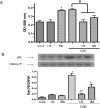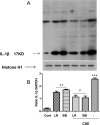Anti-Inflammatory Effects of Lactobacillus Rahmnosus and Bifidobacterium Breve on Cigarette Smoke Activated Human Macrophages
- PMID: 26317628
- PMCID: PMC4552661
- DOI: 10.1371/journal.pone.0136455
Anti-Inflammatory Effects of Lactobacillus Rahmnosus and Bifidobacterium Breve on Cigarette Smoke Activated Human Macrophages
Abstract
Background: Chronic obstructive pulmonary disease (COPD) is a major global health problem with cigarette smoke (CS) as the main risk factor for its development. Airway inflammation in COPD involves the increased expression of inflammatory mediators such as CXCL-8 and IL-1β which are important mediators for neutrophil recruitment. Macrophages are an important source of these mediators in COPD. Lactobacillus rhamnosus (L. rhamnosus) and Befidobacterium breve (B. breve) attenuate the development of 'allergic asthma' in animals but their effects in COPD are unknown.
Objective: To determine the anti-inflammatory effects of L. rhamnosus and B. breve on CS and Toll-like receptor (TLR) activation.
Design: We stimulated the human macrophage cell line THP-1 with CS extract in the presence and absence of L. rhamnosus and B. breve and measured the expression and release of inflammatory mediators by RT-qPCR and ELISA respectively. An activity assay and Western blotting were used to examine NF-κB activation.
Results: Both L. rhamnosus and B. breve were efficiently phagocytized by human macrophages. L. rhamnosus and B. breve significantly suppressed the ability of CS to induce the expression of IL-1β, IL-6, IL-10, IL-23, TNFα, CXCL-8 and HMGB1 release (all p<0.05) in human THP-1 macrophages. Similar suppression of TLR4- and TLR9-induced CXCL8 expression was also observed (p<0.05). The effect of L. rhamnosus and B. breve on inflammatory mediator release was associated with the suppression of CS-induced NF-κB activation (p<0.05).
Conclusions: This data indicate that these probiotics may be useful anti-inflammatory agents in CS-associated disease such as COPD.
Conflict of interest statement
Figures






Similar articles
-
Lactobacillus rhamnosus GG components, SLP, gDNA and CpG, exert protective effects on mouse macrophages upon lipopolysaccharide challenge.Lett Appl Microbiol. 2020 Feb;70(2):118-127. doi: 10.1111/lam.13255. Epub 2019 Dec 18. Lett Appl Microbiol. 2020. PMID: 31782817
-
Bifidobacterium breve CNCM I-4035, Lactobacillus paracasei CNCM I-4034 and Lactobacillus rhamnosus CNCM I-4036 Modulate Macrophage Gene Expression and Ameliorate Damage Markers in the Liver of Zucker-Lepr fa/fa Rats.Nutrients. 2021 Jan 11;13(1):202. doi: 10.3390/nu13010202. Nutrients. 2021. PMID: 33440736 Free PMC article.
-
Differential Toll-like receptor recognition and induction of cytokine profile by Bifidobacterium breve and Lactobacillus strains of probiotics.Clin Vaccine Immunol. 2011 Apr;18(4):621-8. doi: 10.1128/CVI.00498-10. Epub 2011 Feb 2. Clin Vaccine Immunol. 2011. PMID: 21288993 Free PMC article.
-
Signal transduction pathways linking the activation of alveolar macrophages with the recruitment of neutrophils to lungs in chronic obstructive pulmonary disease.Exp Lung Res. 2009 Aug;35(6):439-85. doi: 10.1080/01902140902759290. Exp Lung Res. 2009. PMID: 19842832 Review.
-
The Anti-Inflammatory and Curative Exponent of Probiotics: A Comprehensive and Authentic Ingredient for the Sustained Functioning of Major Human Organs.Nutrients. 2024 Feb 16;16(4):546. doi: 10.3390/nu16040546. Nutrients. 2024. PMID: 38398870 Free PMC article. Review.
Cited by
-
Polydatin alleviates bleomycin-induced pulmonary fibrosis and alters the gut microbiota in a mouse model.J Cell Mol Med. 2023 Dec;27(23):3717-3728. doi: 10.1111/jcmm.17937. Epub 2023 Sep 4. J Cell Mol Med. 2023. PMID: 37665061 Free PMC article.
-
Understanding the role of gut microfloral bifidobacterium in cancer and its potential therapeutic applications.Microbiome Res Rep. 2023 Oct 31;3(1):3. doi: 10.20517/mrr.2023.51. eCollection 2024. Microbiome Res Rep. 2023. PMID: 38455077 Free PMC article. Review.
-
Casticin Improves Respiratory Dysfunction and Attenuates Oxidative Stress and Inflammation via Inhibition of NF-ĸB in a Chronic Obstructive Pulmonary Disease Model of Chronic Cigarette Smoke-Exposed Rats.Drug Des Devel Ther. 2020 Nov 17;14:5019-5027. doi: 10.2147/DDDT.S277126. eCollection 2020. Drug Des Devel Ther. 2020. PMID: 33235440 Free PMC article.
-
Bifidobacterium animalis ssp. lactis Bb12 induces IL-10 through cell membrane-associated components via TLR2 in swine.J Appl Microbiol. 2018 Dec 1;125(6):1881-9. doi: 10.1111/jam.14069. Epub 2018 Aug 14. J Appl Microbiol. 2018. PMID: 30106205 Free PMC article.
-
Association between HMGB1 and COPD: A Systematic Review.Mediators Inflamm. 2015;2015:164913. doi: 10.1155/2015/164913. Epub 2015 Dec 21. Mediators Inflamm. 2015. PMID: 26798204 Free PMC article.
References
-
- Rabe KF, Hurd S, Anzueto A, Barnes PJ, Buist SA, Calverley P, et al. Global strategy for the diagnosis, management, and prevention of chronic obstructive pulmonary disease: GOLD executive summary. American Journal of Respiratory and Critical Care Medicine. 2007;176:532–555. - PubMed
-
- Barnes PJ “Neutrophils find smoke attractive,” Science. 2010; 210:40–41. - PubMed
-
- Rennard SI and Vestbo J COPD: the dangerous underestimate of 15%. The Lancet. 2006;367:1216–1219. - PubMed
-
- Cosio MG, Saetta M, and Agusti A. Immunologic aspects of chronic obstructive pulmonary disease. The New England Journal of Medicine. 2009; 360:2396–2454. - PubMed
Publication types
MeSH terms
Substances
Grants and funding
LinkOut - more resources
Full Text Sources
Other Literature Sources
Medical

